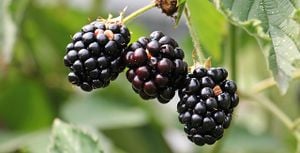No edit summary |
No edit summary |
||
| Line 1: | Line 1: | ||
[[Image:Blackberries01.jpg|thumb|right|Wild blackberries]] | [[Image:Blackberries01.jpg|thumb|right|Wild blackberries]] | ||
Blackberries are the fruit of | Blackberries are the fruit of many ''Rubus'' species grouped together as the ''Rubus fruticosus'' species aggregate{{w|Species complex}}, sometimes commonly referred to as "brambles" or "canefruit" (including raspberries). | ||
==Taxonomy== | ==Taxonomy== | ||
==Varieties== | ==Varieties== | ||
| Line 13: | Line 13: | ||
In the wild, it "moves" by putting down new roots where its arching shoots touch the ground.<ref name=crawford2016 /> | In the wild, it "moves" by putting down new roots where its arching shoots touch the ground.<ref name=crawford2016 /> | ||
==Reproduction== | ==Reproduction== | ||
Self fertile (one plant will fruit by itself).<ref name=crawford2016>Crawford, M (2016). [https://www.worldcat.org/title/creating-a-forest-garden-working-with-nature-to-grow-edible-crops/oclc/1041938577&referer=brief_results Creating a Forest Garden: working with nature to grow edible crops]. Green Books. ISBN 9781900322621.</ref> | White flowers in Spring.<ref name=crawford2016 /> Self fertile (one plant will fruit by itself).<ref name=crawford2016>Crawford, M (2016). [https://www.worldcat.org/title/creating-a-forest-garden-working-with-nature-to-grow-edible-crops/oclc/1041938577&referer=brief_results Creating a Forest Garden: working with nature to grow edible crops]. Green Books. ISBN 9781900322621.</ref> Insect pollinated. | ||
==Hardiness== | ==Hardiness== | ||
==Soil Type== | ==Soil Type== | ||
Tolerant of most soil types.<ref name=crawford2016 /> | |||
==Soil pH== | ==Soil pH== | ||
==Shade Preference== | ==Shade Preference== | ||
Full sun.<ref name=crawford2016 /> | Full sun.<ref name=crawford2016 /> | ||
==Shade Tolerance== | ==Shade Tolerance== | ||
Tolerates fairly deep shade (i.e. no direct sun but some indirect light).<ref name=crawford2016 /> | Tolerates fairly deep shade (i.e. no direct sun but some indirect light).<ref name=crawford2016 /> Fruiting is reduced in shade.<ref name=crawford2016 /> | ||
==Aspect== | ==Aspect== | ||
==Exposure== | ==Exposure== | ||
==Propagation== | ==Propagation== | ||
Hardwood cuttings taken in winter. Tip layering. | |||
Plant potted or bare-rooted new plants in winter.<ref name=crawford2016 /> | |||
==Maintenance== | ==Maintenance== | ||
The plant can stay healthier and more productive if it is allowed to move.<ref name=crawford2016 /> | The plant can stay healthier and more productive if it is allowed to move.<ref name=crawford2016 /> Little maintenance needed.<ref name=crawford2016 /> | ||
==Watering== | ==Watering== | ||
==Pruning== | ==Pruning== | ||
==Problems== | ==Problems== | ||
==Harvest== | ==Harvest== | ||
Fruiting occurs | Fruiting occurs from August to October.<ref name=crawford2016 /> Fruit ripens over several weeks.<ref name=crawford2016 /> In Oklahoma, the berries are picked in the weeks following the July 4th weekend. | ||
In Oklahoma, the berries are picked in the weeks following the July 4th weekend. | |||
When harvesting blackberries, watch out for chiggers (also known as berry bugs, see Trombiculidae{{w|Trombiculidae}}). These are small mites that can cause rashes and itchiness when they bite. | When harvesting blackberries, watch out for chiggers (also known as berry bugs, see Trombiculidae{{w|Trombiculidae}}). These are small mites that can cause rashes and itchiness when they bite. | ||
==Preservation== | ==Preservation== | ||
Fresh fruits do not store for long.<ref name=crawford2016 /> | |||
==Uses== | ==Uses== | ||
* Fruit is edible raw, or cooked. Can be made into jams, cobblers, pies, etc. | |||
* Fruit can be made into wine (see Blackberry wine recepie: [[Making fruit, vegetable and flower wines#Berry Wines]]). | |||
* Bee plant.<ref name=crawford2016 /> | |||
* Young shoots (when spines are still soft) can be cooked.<ref name=crawford2016 /> | |||
* Leaves can be used to make tea.<ref name=crawford2016 /> | |||
* Purple dye from fruit and shoots.<ref name=crawford2016 /> | |||
* Basket weaving (spines can be removed by pulling stems through a small hole).<ref name=crawford2016 /> | |||
==Nutritional Values== | ==Nutritional Values== | ||
==Cooking== | ==Cooking== | ||
==References== | ==References== | ||
{{reflist}} | {{reflist}} | ||
== External links == | == External links == | ||
Revision as of 16:01, 23 March 2019

Blackberries are the fruit of many Rubus species grouped together as the Rubus fruticosus species aggregateW, sometimes commonly referred to as "brambles" or "canefruit" (including raspberries).
Taxonomy
Varieties
Common names
Etymology
Range
History
Morphology
Behaviour
Deciduous shrub.[1] Growth habit is long and scrambling.[1] It is perennial but the stems are biennial, fruiting on the second year.
In the wild, it "moves" by putting down new roots where its arching shoots touch the ground.[1]
Reproduction
White flowers in Spring.[1] Self fertile (one plant will fruit by itself).[1] Insect pollinated.
Hardiness
Soil Type
Tolerant of most soil types.[1]
Soil pH
Shade Preference
Full sun.[1]
Shade Tolerance
Tolerates fairly deep shade (i.e. no direct sun but some indirect light).[1] Fruiting is reduced in shade.[1]
Aspect
Exposure
Propagation
Hardwood cuttings taken in winter. Tip layering.
Plant potted or bare-rooted new plants in winter.[1]
Maintenance
The plant can stay healthier and more productive if it is allowed to move.[1] Little maintenance needed.[1]
Watering
Pruning
Problems
Harvest
Fruiting occurs from August to October.[1] Fruit ripens over several weeks.[1] In Oklahoma, the berries are picked in the weeks following the July 4th weekend.
When harvesting blackberries, watch out for chiggers (also known as berry bugs, see TrombiculidaeW). These are small mites that can cause rashes and itchiness when they bite.
Preservation
Fresh fruits do not store for long.[1]
Uses
- Fruit is edible raw, or cooked. Can be made into jams, cobblers, pies, etc.
- Fruit can be made into wine (see Blackberry wine recepie: Making fruit, vegetable and flower wines#Berry Wines).
- Bee plant.[1]
- Young shoots (when spines are still soft) can be cooked.[1]
- Leaves can be used to make tea.[1]
- Purple dye from fruit and shoots.[1]
- Basket weaving (spines can be removed by pulling stems through a small hole).[1]